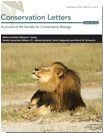Public trust thinking emphasizes the role of government in public wildlife conservation. 1 2 3 4 This makes sense in the U.S., where wildlife is held in trust by government and managed for the benefit of current and future citizens. Nevertheless, nongovernmental actors such as non-profit organizations, for-profit organizations, private landowners, and community groups contribute significantly to wildlife conservation, sometimes through partnerships with public wildlife agencies. 5 6 7 Such partnerships can ensure comprehensive and effective public wildlife conservation to places, issues, and species that public wildlife agencies cannot reach on their own, for example on private land or in relation to species that public wildlife agencies have not traditionally emphasized. 8 9 10 Aligning behaviors and practices with wildlife governance principles could allow public wildlife agencies to develop stronger, more inclusive, and more effective partnerships with nongovernmental organizations. 11
Scholars and practitioners have paid attention to how nongovernmental actors contribute to public wildlife governance inspired by public trust thinking. 12 13 14 Some of this attention has included formal and informal partnerships between public wildlife agencies and private landowners (individual or corporate), for example through payments to protect or conserve habitats, developing wildlife management plans for private landowners, or to defraying losses associated with wildlife depredation on crops or livestock. 15 However, the majority of attention has focused on partnerships between public wildlife agencies and nongovernmental organizations (NGOs) and nonprofit groups that range from voluntary community organizations to powerful international conservation groups. 16
NGOs communicate beneficiaries’ interests to public wildlife agencies and contribute expertise, resources, and operational support to public wildlife conservation. 17 But partnerships between public wildlife agencies and NGOs can be complicated. Trust administrators potentially risk relinquishing their obligations (or could create the perception of doing so) to represent all beneficiaries’ interests, especially when partnering with NGOs committed to particular species, habitats or wildlife-related activities. 18 19
Trust administrators could address such risks by partnering with multiple NGOs having a wide range of mandates and specifying partnership objectives and roles of all partners in contracts or memoranda of understanding. 20 This approach would allow trust administrators to avoid disproportionate focus on particular species or activities, increase relevance, credibility, and legitimacy by incorporating more diverse public interests into public wildlife conservation, and retain public oversight of partnership objectives and outcomes. 21
However, it is not clear whether NGOs would welcome additional obligations that could accompany formal partnerships. Some NGOs might be reluctant to enter partnerships with public wildlife agencies that have historically overlooked the interests they represent. 22 Other NGOs might perceive requirements for transparency, accountability, or oversight as placing undesirable constraints on their autonomy or their capacity to secure anonymous donations. 23 NGOs might see partnerships with public wildlife agencies as hindering or unnecessarily complicating progress towards their preferred conservation objectives. 24
Identifying models for mutually-agreeable partnerships that synergize conservation efforts by governmental and nongovernmental entities would represent a major advance for proponents of public trust thinking. 25
Back to the Public Trust Anthology main page
Featured Publications
Click on the image to be directed to the article website. Placing your cursor on the text will automatically stop the movement.
- Applying Public Trust Thinking to Wildlife Governance in the United States: Challenges and Solutions ↩
- Governance Principles for Wildlife Conservation in the 21st Century ↩
- Principles of Public Trust Thinking ↩
- NGOs Enhance State Wildlife Agencies’ Capacity to Meet Public Trust Doctrine Obligations ↩
- Applying Public Trust Thinking to Wildlife Governance in the United States: Challenges and Solutions ↩
- Landscape Conservation Cooperatives: Building a Network to Help Fulfill Public Trust Obligations ↩
- NGOs Enhance State Wildlife Agencies’ Capacity to Meet Public Trust Doctrine Obligations ↩
- Applying Public Trust Thinking to Wildlife Governance in the United States: Challenges and Solutions ↩
- Landscape Conservation Cooperatives: Building a Network to Help Fulfill Public Trust Obligations ↩
- NGOs Enhance State Wildlife Agencies’ Capacity to Meet Public Trust Doctrine Obligations ↩
- Governance Principles for Wildlife Conservation in the 21st Century ↩
- Applying Public Trust Thinking to Wildlife Governance in the United States: Challenges and Solutions ↩
- Landscape Conservation Cooperatives: Building a Network to Help Fulfill Public Trust Obligations ↩
- NGOs Enhance State Wildlife Agencies’ Capacity to Meet Public Trust Doctrine Obligations ↩
- NGOs Enhance State Wildlife Agencies’ Capacity to Meet Public Trust Doctrine Obligations ↩
- NGOs Enhance State Wildlife Agencies’ Capacity to Meet Public Trust Doctrine Obligations ↩
- NGOs Enhance State Wildlife Agencies’ Capacity to Meet Public Trust Doctrine Obligations ↩
- Applying Public Trust Thinking to Wildlife Governance in the United States: Challenges and Solutions ↩
- NGOs Enhance State Wildlife Agencies’ Capacity to Meet Public Trust Doctrine Obligations ↩
- Applying Public Trust Thinking to Wildlife Governance in the United States: Challenges and Solutions ↩
- Applying Public Trust Thinking to Wildlife Governance in the United States: Challenges and Solutions ↩
- Applying Public Trust Thinking to Wildlife Governance in the United States: Challenges and Solutions ↩
- Applying Public Trust Thinking to Wildlife Governance in the United States: Challenges and Solutions ↩
- Applying Public Trust Thinking to Wildlife Governance in the United States: Challenges and Solutions ↩
- Applying Public Trust Thinking to Wildlife Governance in the United States: Challenges and Solutions ↩


